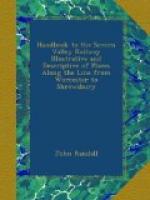[Waterfall: 31.jpg]
The Wellington and Severn Junction line through Coalbrookdale is joined by the branch line to
WENLOCK,
one of the oldest borough towns in the kingdom. Its chief attraction is the Abbey, founded by St. Milburgh, a Saxon saint, and daughter of Penda, one of the last and fiercest of the Saxon heathen kings. It fell before the Danes, but was rebuilt by Earl Leofric and his wife Godiva. A second time it fell, and was again rebuilt; this time by Norman masons, in greater splendour than before. Of the architecture of this period the present ruins show some fine examples, and none finer than the chapter-house, the clustering arches of which are shown in our engraving.
The south transept, with a portion of the nave, of the Early English style of architecture, remind the visitor of the stately grandeur of the church, which was upwards of 400 feet in length. The house of the prior, which communicated with the chapter-house, is now the private residence of J. M. Gaskell, Esq., M.P., the present proprietor of the estate. The parish church has several points of interest, one of which is its fine Norman front, hidden from the street by the present tower. To this may also be added the arches which separate the nave and side aisles, rising from clustering pillars of great beauty; also the one dividing the nave from the chancel, where there is an elegant sedilia. Wenlock grew up beneath the patronage and protection of its Priory, by means of which it received many royal favours, and was protected by many royal charters, one of which conferred the right, at a very early period, of representation in the Commons House of Parliament.
[The Chapter-House of Wenlock Abbey: 32.jpg]
The Guildhall is an ancient building of timber and plaster, with a projecting upper story resting on piazzas. The room used for quarter sessions has the arms of Charles II. over the recorder’s chair, and the Inner or Municipal Court is beautifully furnished with elaborately-carved oak panellings and furniture. The borough is nearly the same now as formerly, the modern franchise extending over the ancient possessions of the church, wherein the prior of the monastery had jurisdiction over eighteen parishes.




